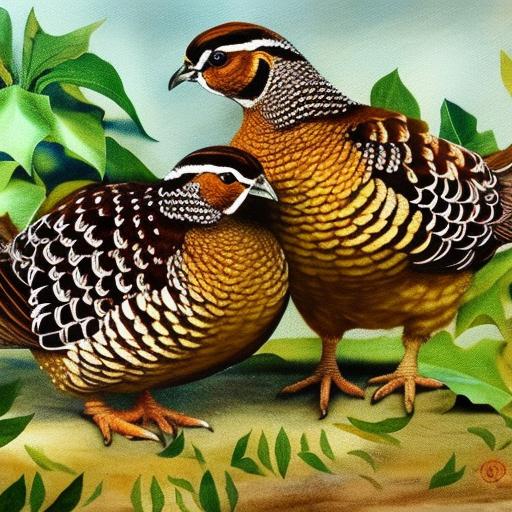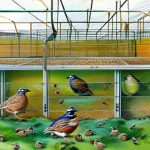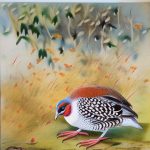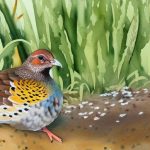When it comes to selecting the right quail for your farm or backyard, there are a few key factors to consider. First and foremost, you’ll want to decide on the breed of quail that best suits your needs. There are several popular breeds to choose from, including the Coturnix quail, Bobwhite quail, and California quail, each with its own unique characteristics and traits. Consider factors such as egg production, meat quality, and temperament when making your decision.
In addition to breed, it’s important to consider the age and health of the quail you’re bringing into your flock. If you’re looking to start a breeding program, you’ll want to select healthy, young birds with good genetics. On the other hand, if you’re simply looking for quail for eggs or meat, you may opt for older birds that are already laying or ready for processing. Regardless of your goals, it’s crucial to source your quail from a reputable breeder or supplier to ensure you’re getting healthy, disease-free birds. Taking the time to carefully select the right quail for your specific needs will set you up for success in all aspects of quail farming.
Key Takeaways
- Select quails with good genetics and from reputable breeders to ensure healthy and productive birds
- Provide a spacious and well-ventilated housing environment for quails to thrive
- Offer a balanced diet of commercial quail feed supplemented with fresh greens and protein sources
- Create optimal conditions for breeding and mating, including providing nesting boxes and monitoring mating behavior
- Maintain proper temperature and humidity levels during incubation and provide a clean and warm environment for hatched chicks
- Monitor the health of quails regularly and provide necessary vaccinations and treatments to prevent diseases and parasites
Housing and Environment
Creating the right housing and environment for your quail is essential for their health and well-being. Quail are relatively small birds, so they don’t require a large amount of space individually, but they do need enough room to move around comfortably. When it comes to housing, you have several options to choose from, including cages, hutches, or aviaries. Regardless of the type of housing you choose, it’s important to provide adequate ventilation, protection from predators, and easy access for cleaning and maintenance.
In addition to housing, the environment in which your quail are kept plays a crucial role in their overall health and productivity. Quail thrive in environments with plenty of natural light, access to fresh air, and protection from extreme temperatures. It’s also important to provide a substrate such as straw or wood shavings for nesting and dust bathing. Creating a comfortable and stimulating environment for your quail will not only keep them happy and healthy but also contribute to their overall productivity.
Nutrition and Feeding
Proper nutrition is essential for the health and productivity of your quail. When it comes to feeding your quail, it’s important to provide a balanced diet that meets their specific nutritional needs. A high-quality commercial quail feed is a good foundation for their diet, but it’s also important to supplement with fresh greens, fruits, and vegetables to ensure they’re getting a wide range of nutrients. Additionally, providing access to grit or crushed oyster shells will help with digestion and eggshell formation.
Water is another crucial component of a quail’s diet. It’s important to provide clean, fresh water at all times, as quail can quickly become dehydrated if they don’t have access to an adequate water source. In addition to their regular diet, it’s important to monitor your quail’s food intake and adjust their feeding regimen as needed based on factors such as age, season, and production goals. By providing a well-rounded and nutritious diet, you’ll ensure that your quail are healthy and productive.
Breeding and Mating
Breeding and mating are important aspects of quail farming, especially if you’re looking to maintain a self-sustaining flock or increase your numbers for meat or egg production. When it comes to breeding quail, it’s important to provide the right conditions to encourage mating behavior. This includes ensuring that your quail have enough space, privacy, and a balanced diet to support healthy reproductive activity.
In terms of mating behavior, male quail will often display courtship behaviors such as strutting, calling, and displaying their plumage to attract females. It’s important to provide a ratio of one male to every three or four females to prevent over-mating and aggression among the males. Additionally, providing plenty of nesting areas with suitable substrate will encourage females to lay their eggs in a safe and comfortable environment. By creating the right conditions for breeding and mating, you’ll be able to maintain a healthy and productive quail flock for years to come.
Incubation and Hatching
Once your quail have successfully mated and laid their eggs, it’s time to think about incubation and hatching. If you’re looking to hatch your own quail chicks, investing in a reliable incubator is essential. There are many different types of incubators available on the market, ranging from basic models to more advanced options with automatic turning and temperature control features. Regardless of the type of incubator you choose, it’s important to closely monitor temperature and humidity levels throughout the entire incubation period.
In addition to proper equipment, it’s important to handle the eggs with care during the incubation process. Turning the eggs several times a day will help prevent the embryos from sticking to the shell membrane and ensure proper development. It’s also important to monitor the development of the embryos by candling the eggs periodically to check for signs of growth and viability. By providing the right conditions and care during incubation, you’ll increase the likelihood of a successful hatch and healthy quail chicks.
Caring for Chicks

Once your quail chicks have hatched, it’s important to provide them with the right care and environment to ensure their health and well-being. The first few weeks of a chick’s life are crucial for their development, so it’s important to provide them with a warm, clean, and safe environment. A brooder with a heat lamp or heating pad will help maintain the right temperature for the chicks, while also providing them with enough space to move around comfortably.
In addition to warmth, it’s important to provide the chicks with access to clean water and a high-quality chick starter feed that’s specifically formulated for their nutritional needs. It’s also important to monitor the chicks closely for signs of illness or distress and provide any necessary medical care as soon as possible. As the chicks grow, it’s important to gradually introduce them to their eventual outdoor environment by providing access to natural light and fresh air. By providing attentive care during the crucial early stages of their lives, you’ll set your quail chicks up for success as they mature into healthy adults.
Health and Maintenance
Maintaining the health of your quail flock is essential for their overall well-being and productivity. Regular health checks are important for monitoring the condition of your birds and identifying any potential issues early on. This includes checking for signs of illness or injury, monitoring egg production and quality, and ensuring that your birds have access to clean water and a balanced diet.
In addition to regular health checks, it’s important to keep your quail housing clean and well-maintained. This includes regularly cleaning out bedding material, removing waste, and disinfecting the living areas to prevent the spread of disease. Providing adequate ventilation and protection from predators will also contribute to the overall health and safety of your quail flock.
In conclusion, successful quail farming requires careful consideration of various factors including selecting the right breed of quail, providing suitable housing and environment, ensuring proper nutrition and feeding practices, managing breeding and mating activities, handling incubation and hatching processes with care, providing attentive care for chicks, and maintaining the health and well-being of your flock through regular maintenance practices. By paying close attention to these key aspects of quail farming, you’ll be well-equipped to raise healthy and productive quail for eggs or meat production.
If you’re interested in raising a breeding pair of jumbo brown coturnix quail, you may also want to consider the importance of providing a suitable coop for your birds. A well-designed coop can contribute to the health and productivity of your quail. For tips on creating an ideal living space for your quail, check out this informative article on poultrywizard.com.
FAQs
What is a jumbo brown coturnix quail?
A jumbo brown coturnix quail is a breed of quail that is larger in size compared to other coturnix quail varieties. They are known for their fast growth and high egg production, making them popular for breeding and raising for meat and eggs.
How do I raise a breeding pair of jumbo brown coturnix quail?
To raise a breeding pair of jumbo brown coturnix quail, you will need to provide them with a suitable habitat, proper nutrition, and a conducive environment for breeding. This includes a spacious cage or aviary, a balanced diet of quail feed and fresh water, and nesting boxes for the female to lay her eggs.
What should I feed my breeding pair of jumbo brown coturnix quail?
A balanced diet for jumbo brown coturnix quail should consist of high-quality quail feed, which can be supplemented with fresh greens, fruits, and vegetables. It is important to provide them with a diet that is rich in protein, vitamins, and minerals to support their growth and reproductive health.
How do I encourage breeding in my jumbo brown coturnix quail pair?
To encourage breeding in your jumbo brown coturnix quail pair, you can provide them with a suitable nesting area, a diet rich in protein, and a consistent lighting schedule. Additionally, ensuring that the quail are not stressed and have enough space in their habitat can also help encourage breeding behavior.
What should I consider when selecting a breeding pair of jumbo brown coturnix quail?
When selecting a breeding pair of jumbo brown coturnix quail, it is important to choose healthy, unrelated birds with good genetics. Look for birds that are active, have bright eyes, and are free from any signs of illness or deformities. It is also advisable to choose birds that come from a reputable breeder or source.
Meet Walter, the feathered-friend fanatic of Florida! Nestled in the sunshine state, Walter struts through life with his feathered companions, clucking his way to happiness. With a coop that’s fancier than a five-star hotel, he’s the Don Juan of the chicken world. When he’s not teaching his hens to do the cha-cha, you’ll find him in a heated debate with his prized rooster, Sir Clucks-a-Lot. Walter’s poultry passion is no yolk; he’s the sunny-side-up guy you never knew you needed in your flock of friends!







